Economical Electricity Generation from Waste Water Project
VerifiedAdded on 2020/05/04
|24
|4316
|61
Project
AI Summary
This engineering project focuses on the economical generation of electricity from wastewater, a renewable energy source. The project aims to design and implement a system to convert the kinetic energy of wastewater flow into electrical energy sufficient for household appliances. The introduction highlights the global shift towards renewable energy and the project's focus on utilizing waste resources to generate electricity. The literature review covers hydropower, water energy sources (reservoirs, rivers, run-of-the-river plants, micro and pico hydro), advantages and disadvantages of water energy, and power calculation formulas. The project also includes research questions, theoretical content on energy storage and turbine design (impulse and reaction turbines), and experimental setup details. The project aims to provide an economical and sustainable solution for household electricity needs, offering a practical application of renewable energy principles. The project also explores the potential for scalability and addresses environmental considerations.

ENGINEERING PROJECT
ECONOMICAL ELECTRICITY GENERATION FROM WASTE WATER
ECONOMICAL ELECTRICITY GENERATION FROM WASTE WATER
Paraphrase This Document
Need a fresh take? Get an instant paraphrase of this document with our AI Paraphraser
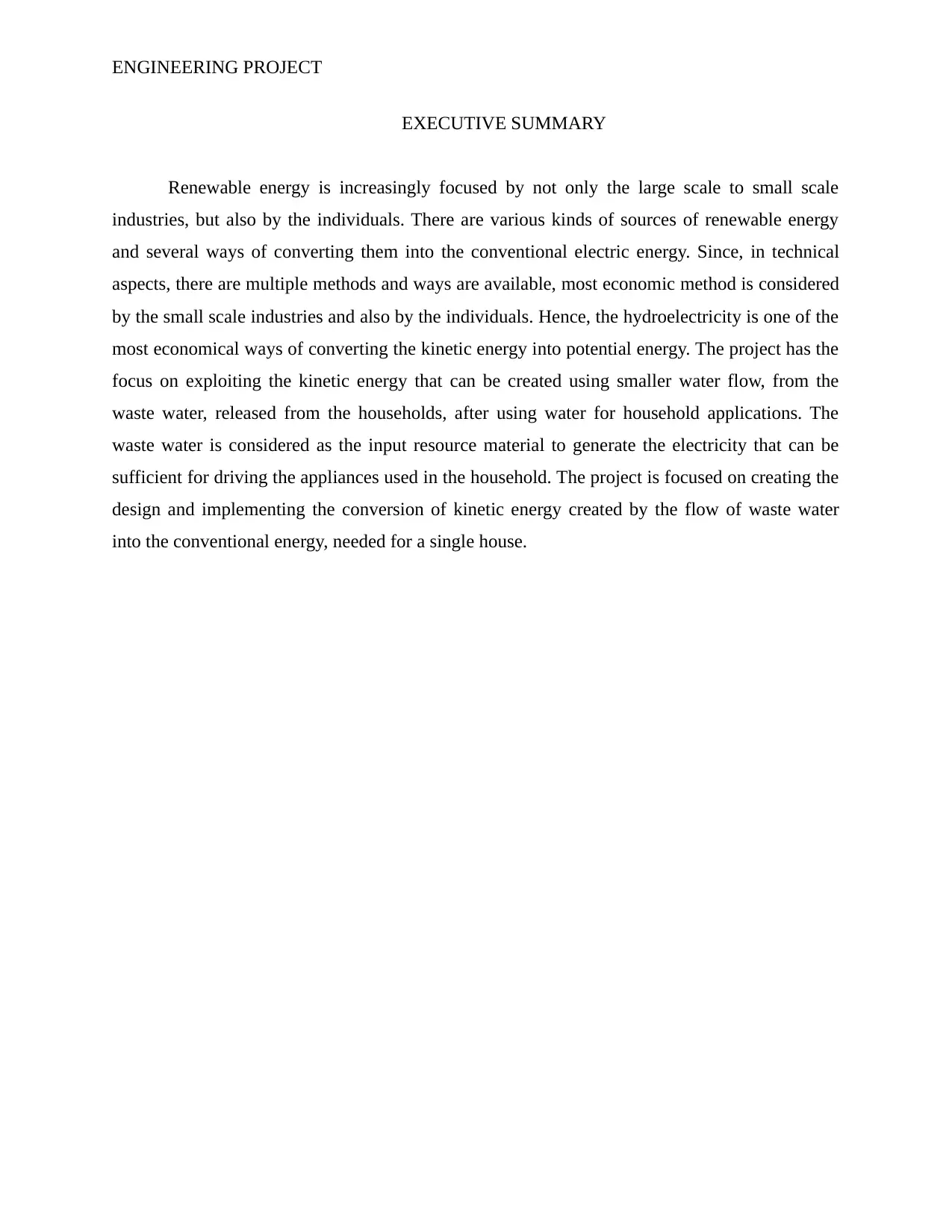
ENGINEERING PROJECT
EXECUTIVE SUMMARY
Renewable energy is increasingly focused by not only the large scale to small scale
industries, but also by the individuals. There are various kinds of sources of renewable energy
and several ways of converting them into the conventional electric energy. Since, in technical
aspects, there are multiple methods and ways are available, most economic method is considered
by the small scale industries and also by the individuals. Hence, the hydroelectricity is one of the
most economical ways of converting the kinetic energy into potential energy. The project has the
focus on exploiting the kinetic energy that can be created using smaller water flow, from the
waste water, released from the households, after using water for household applications. The
waste water is considered as the input resource material to generate the electricity that can be
sufficient for driving the appliances used in the household. The project is focused on creating the
design and implementing the conversion of kinetic energy created by the flow of waste water
into the conventional energy, needed for a single house.
EXECUTIVE SUMMARY
Renewable energy is increasingly focused by not only the large scale to small scale
industries, but also by the individuals. There are various kinds of sources of renewable energy
and several ways of converting them into the conventional electric energy. Since, in technical
aspects, there are multiple methods and ways are available, most economic method is considered
by the small scale industries and also by the individuals. Hence, the hydroelectricity is one of the
most economical ways of converting the kinetic energy into potential energy. The project has the
focus on exploiting the kinetic energy that can be created using smaller water flow, from the
waste water, released from the households, after using water for household applications. The
waste water is considered as the input resource material to generate the electricity that can be
sufficient for driving the appliances used in the household. The project is focused on creating the
design and implementing the conversion of kinetic energy created by the flow of waste water
into the conventional energy, needed for a single house.
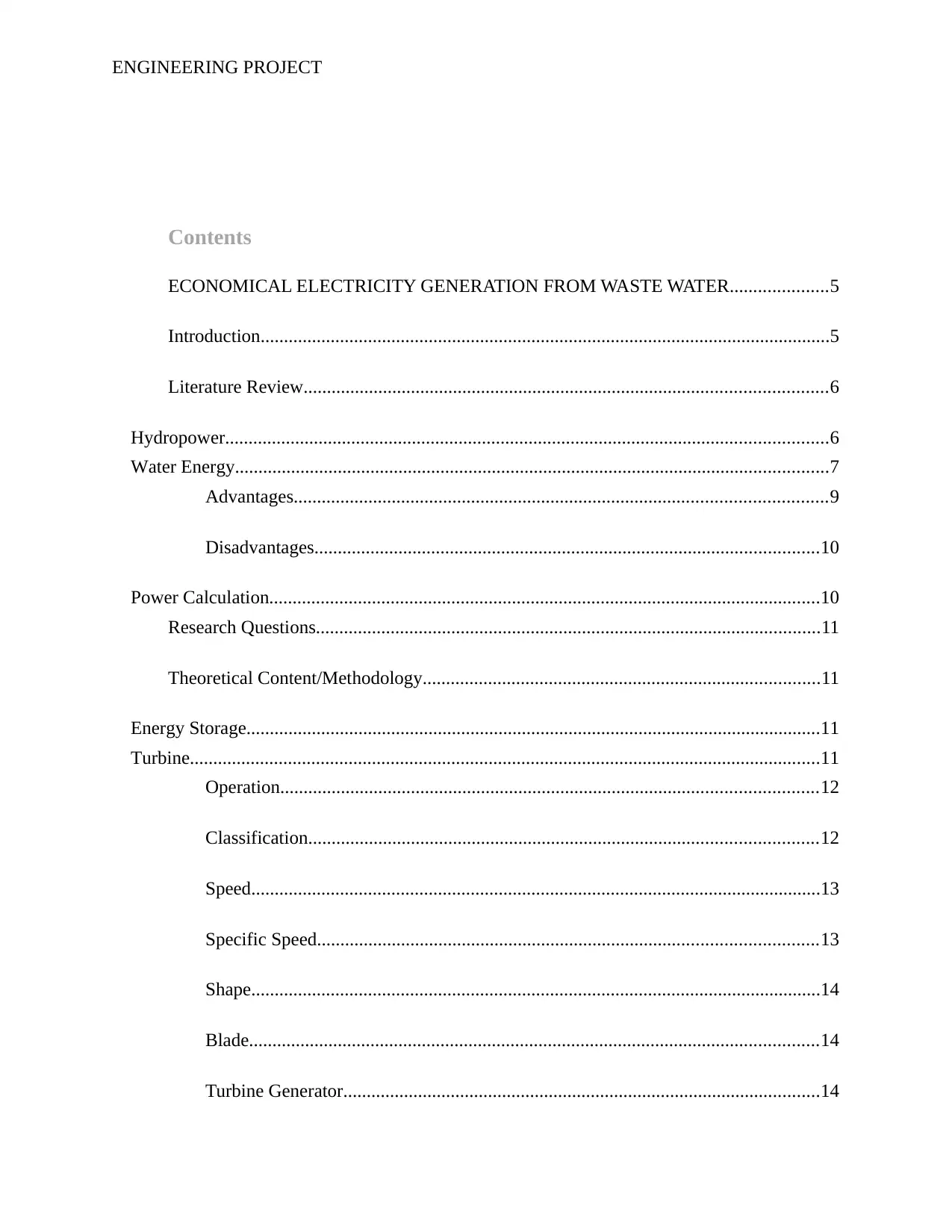
ENGINEERING PROJECT
Contents
ECONOMICAL ELECTRICITY GENERATION FROM WASTE WATER.....................5
Introduction..........................................................................................................................5
Literature Review................................................................................................................6
Hydropower.................................................................................................................................6
Water Energy...............................................................................................................................7
Advantages..................................................................................................................9
Disadvantages............................................................................................................10
Power Calculation......................................................................................................................10
Research Questions............................................................................................................11
Theoretical Content/Methodology.....................................................................................11
Energy Storage...........................................................................................................................11
Turbine.......................................................................................................................................11
Operation...................................................................................................................12
Classification.............................................................................................................12
Speed..........................................................................................................................13
Specific Speed...........................................................................................................13
Shape..........................................................................................................................14
Blade..........................................................................................................................14
Turbine Generator......................................................................................................14
Contents
ECONOMICAL ELECTRICITY GENERATION FROM WASTE WATER.....................5
Introduction..........................................................................................................................5
Literature Review................................................................................................................6
Hydropower.................................................................................................................................6
Water Energy...............................................................................................................................7
Advantages..................................................................................................................9
Disadvantages............................................................................................................10
Power Calculation......................................................................................................................10
Research Questions............................................................................................................11
Theoretical Content/Methodology.....................................................................................11
Energy Storage...........................................................................................................................11
Turbine.......................................................................................................................................11
Operation...................................................................................................................12
Classification.............................................................................................................12
Speed..........................................................................................................................13
Specific Speed...........................................................................................................13
Shape..........................................................................................................................14
Blade..........................................................................................................................14
Turbine Generator......................................................................................................14
⊘ This is a preview!⊘
Do you want full access?
Subscribe today to unlock all pages.

Trusted by 1+ million students worldwide
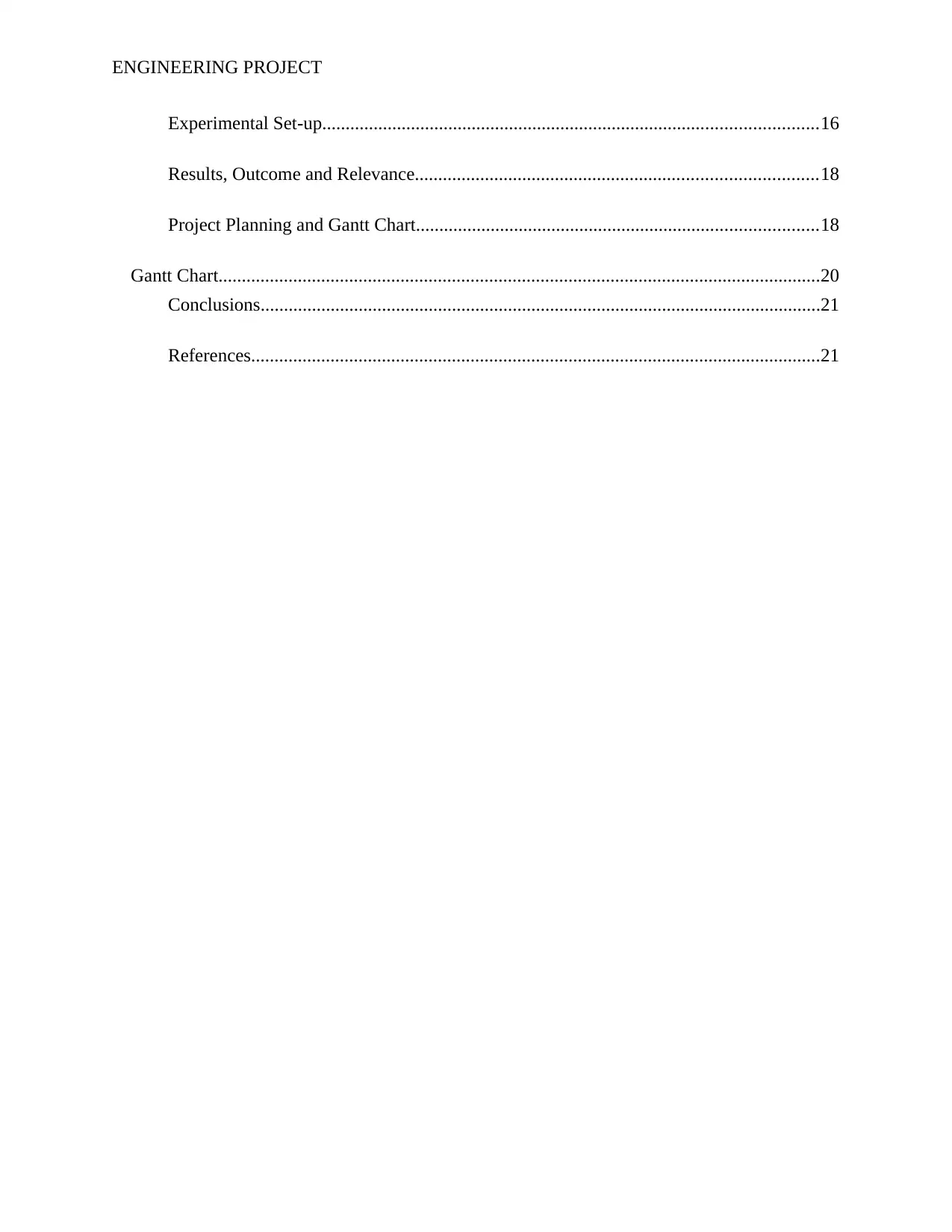
ENGINEERING PROJECT
Experimental Set-up..........................................................................................................16
Results, Outcome and Relevance......................................................................................18
Project Planning and Gantt Chart......................................................................................18
Gantt Chart.................................................................................................................................20
Conclusions........................................................................................................................21
References..........................................................................................................................21
Experimental Set-up..........................................................................................................16
Results, Outcome and Relevance......................................................................................18
Project Planning and Gantt Chart......................................................................................18
Gantt Chart.................................................................................................................................20
Conclusions........................................................................................................................21
References..........................................................................................................................21
Paraphrase This Document
Need a fresh take? Get an instant paraphrase of this document with our AI Paraphraser
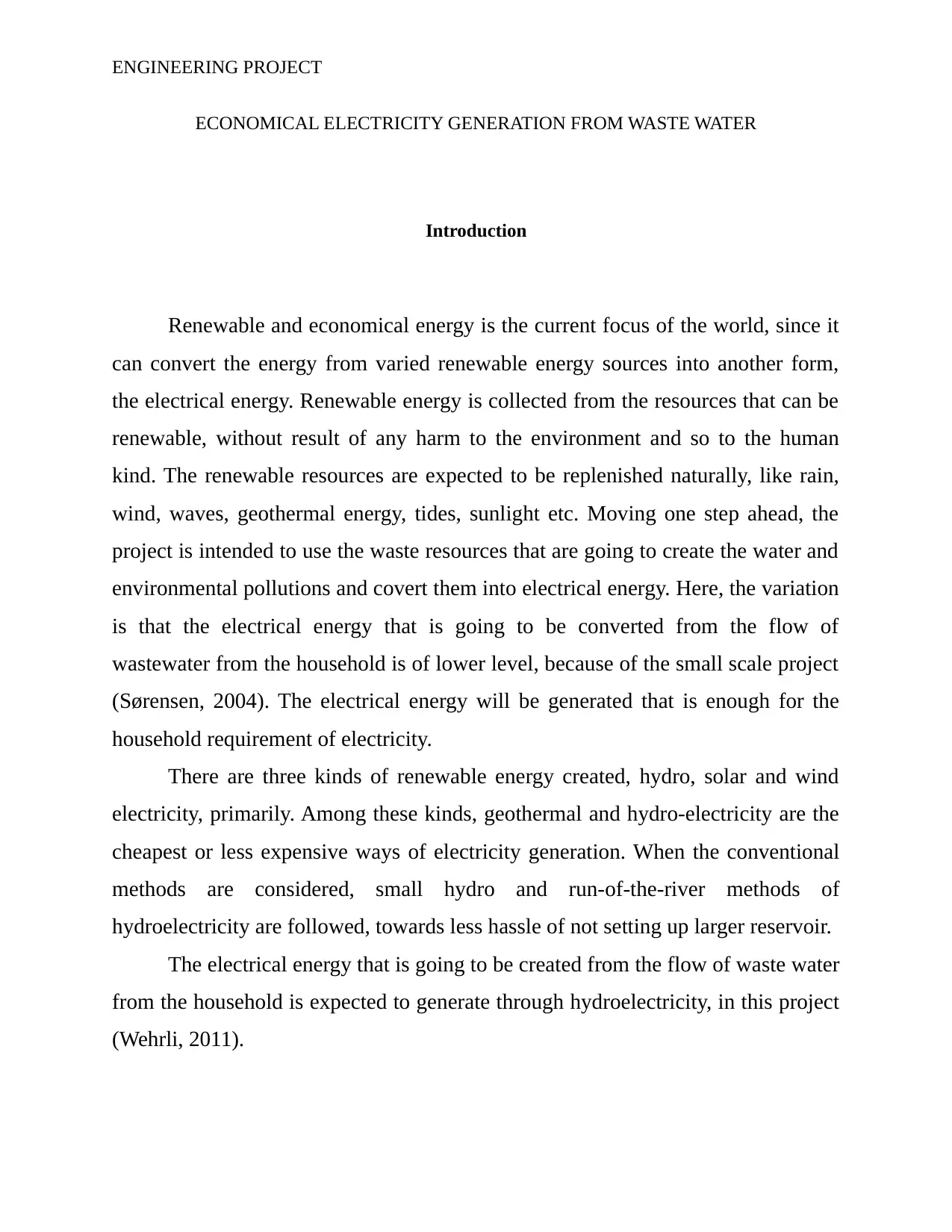
ENGINEERING PROJECT
ECONOMICAL ELECTRICITY GENERATION FROM WASTE WATER
Introduction
Renewable and economical energy is the current focus of the world, since it
can convert the energy from varied renewable energy sources into another form,
the electrical energy. Renewable energy is collected from the resources that can be
renewable, without result of any harm to the environment and so to the human
kind. The renewable resources are expected to be replenished naturally, like rain,
wind, waves, geothermal energy, tides, sunlight etc. Moving one step ahead, the
project is intended to use the waste resources that are going to create the water and
environmental pollutions and covert them into electrical energy. Here, the variation
is that the electrical energy that is going to be converted from the flow of
wastewater from the household is of lower level, because of the small scale project
(Sørensen, 2004). The electrical energy will be generated that is enough for the
household requirement of electricity.
There are three kinds of renewable energy created, hydro, solar and wind
electricity, primarily. Among these kinds, geothermal and hydro-electricity are the
cheapest or less expensive ways of electricity generation. When the conventional
methods are considered, small hydro and run-of-the-river methods of
hydroelectricity are followed, towards less hassle of not setting up larger reservoir.
The electrical energy that is going to be created from the flow of waste water
from the household is expected to generate through hydroelectricity, in this project
(Wehrli, 2011).
ECONOMICAL ELECTRICITY GENERATION FROM WASTE WATER
Introduction
Renewable and economical energy is the current focus of the world, since it
can convert the energy from varied renewable energy sources into another form,
the electrical energy. Renewable energy is collected from the resources that can be
renewable, without result of any harm to the environment and so to the human
kind. The renewable resources are expected to be replenished naturally, like rain,
wind, waves, geothermal energy, tides, sunlight etc. Moving one step ahead, the
project is intended to use the waste resources that are going to create the water and
environmental pollutions and covert them into electrical energy. Here, the variation
is that the electrical energy that is going to be converted from the flow of
wastewater from the household is of lower level, because of the small scale project
(Sørensen, 2004). The electrical energy will be generated that is enough for the
household requirement of electricity.
There are three kinds of renewable energy created, hydro, solar and wind
electricity, primarily. Among these kinds, geothermal and hydro-electricity are the
cheapest or less expensive ways of electricity generation. When the conventional
methods are considered, small hydro and run-of-the-river methods of
hydroelectricity are followed, towards less hassle of not setting up larger reservoir.
The electrical energy that is going to be created from the flow of waste water
from the household is expected to generate through hydroelectricity, in this project
(Wehrli, 2011).

ENGINEERING PROJECT
Literature Review
Hydropower
The current share of hydroelectricity in the renewable energy is 3.9% of
hydro electricity, in terms of electricity consumption. The hydro electricity is
usually generated in larger scale, by employing the large dams, etc. In terms of
hydropower, total 16.6% of electricity is generated, in the world (Sørensen, 2004).
Hydropower can be generated by using water, since density of water is 800
times more than that of the air. So, water, even when it flows, from a moderate sea
swell or in a small stream can enable the generation of energy. Largest amount of
hydroelectricity is produced by China, having about 45,000 installations of hydro
power in smaller scale.
Figure: Hydroelectric System and Dam
Literature Review
Hydropower
The current share of hydroelectricity in the renewable energy is 3.9% of
hydro electricity, in terms of electricity consumption. The hydro electricity is
usually generated in larger scale, by employing the large dams, etc. In terms of
hydropower, total 16.6% of electricity is generated, in the world (Sørensen, 2004).
Hydropower can be generated by using water, since density of water is 800
times more than that of the air. So, water, even when it flows, from a moderate sea
swell or in a small stream can enable the generation of energy. Largest amount of
hydroelectricity is produced by China, having about 45,000 installations of hydro
power in smaller scale.
Figure: Hydroelectric System and Dam
⊘ This is a preview!⊘
Do you want full access?
Subscribe today to unlock all pages.

Trusted by 1+ million students worldwide
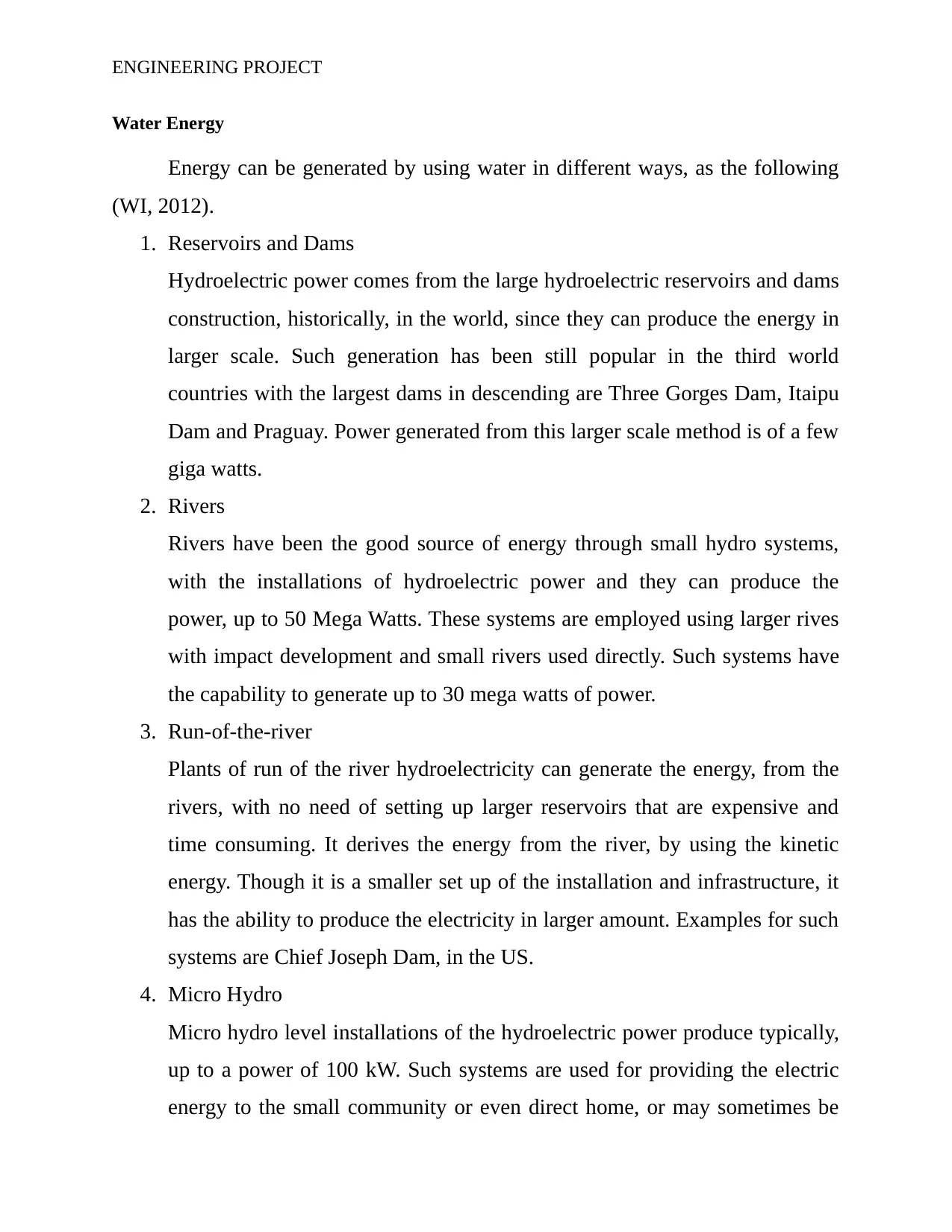
ENGINEERING PROJECT
Water Energy
Energy can be generated by using water in different ways, as the following
(WI, 2012).
1. Reservoirs and Dams
Hydroelectric power comes from the large hydroelectric reservoirs and dams
construction, historically, in the world, since they can produce the energy in
larger scale. Such generation has been still popular in the third world
countries with the largest dams in descending are Three Gorges Dam, Itaipu
Dam and Praguay. Power generated from this larger scale method is of a few
giga watts.
2. Rivers
Rivers have been the good source of energy through small hydro systems,
with the installations of hydroelectric power and they can produce the
power, up to 50 Mega Watts. These systems are employed using larger rives
with impact development and small rivers used directly. Such systems have
the capability to generate up to 30 mega watts of power.
3. Run-of-the-river
Plants of run of the river hydroelectricity can generate the energy, from the
rivers, with no need of setting up larger reservoirs that are expensive and
time consuming. It derives the energy from the river, by using the kinetic
energy. Though it is a smaller set up of the installation and infrastructure, it
has the ability to produce the electricity in larger amount. Examples for such
systems are Chief Joseph Dam, in the US.
4. Micro Hydro
Micro hydro level installations of the hydroelectric power produce typically,
up to a power of 100 kW. Such systems are used for providing the electric
energy to the small community or even direct home, or may sometimes be
Water Energy
Energy can be generated by using water in different ways, as the following
(WI, 2012).
1. Reservoirs and Dams
Hydroelectric power comes from the large hydroelectric reservoirs and dams
construction, historically, in the world, since they can produce the energy in
larger scale. Such generation has been still popular in the third world
countries with the largest dams in descending are Three Gorges Dam, Itaipu
Dam and Praguay. Power generated from this larger scale method is of a few
giga watts.
2. Rivers
Rivers have been the good source of energy through small hydro systems,
with the installations of hydroelectric power and they can produce the
power, up to 50 Mega Watts. These systems are employed using larger rives
with impact development and small rivers used directly. Such systems have
the capability to generate up to 30 mega watts of power.
3. Run-of-the-river
Plants of run of the river hydroelectricity can generate the energy, from the
rivers, with no need of setting up larger reservoirs that are expensive and
time consuming. It derives the energy from the river, by using the kinetic
energy. Though it is a smaller set up of the installation and infrastructure, it
has the ability to produce the electricity in larger amount. Examples for such
systems are Chief Joseph Dam, in the US.
4. Micro Hydro
Micro hydro level installations of the hydroelectric power produce typically,
up to a power of 100 kW. Such systems are used for providing the electric
energy to the small community or even direct home, or may sometimes be
Paraphrase This Document
Need a fresh take? Get an instant paraphrase of this document with our AI Paraphraser
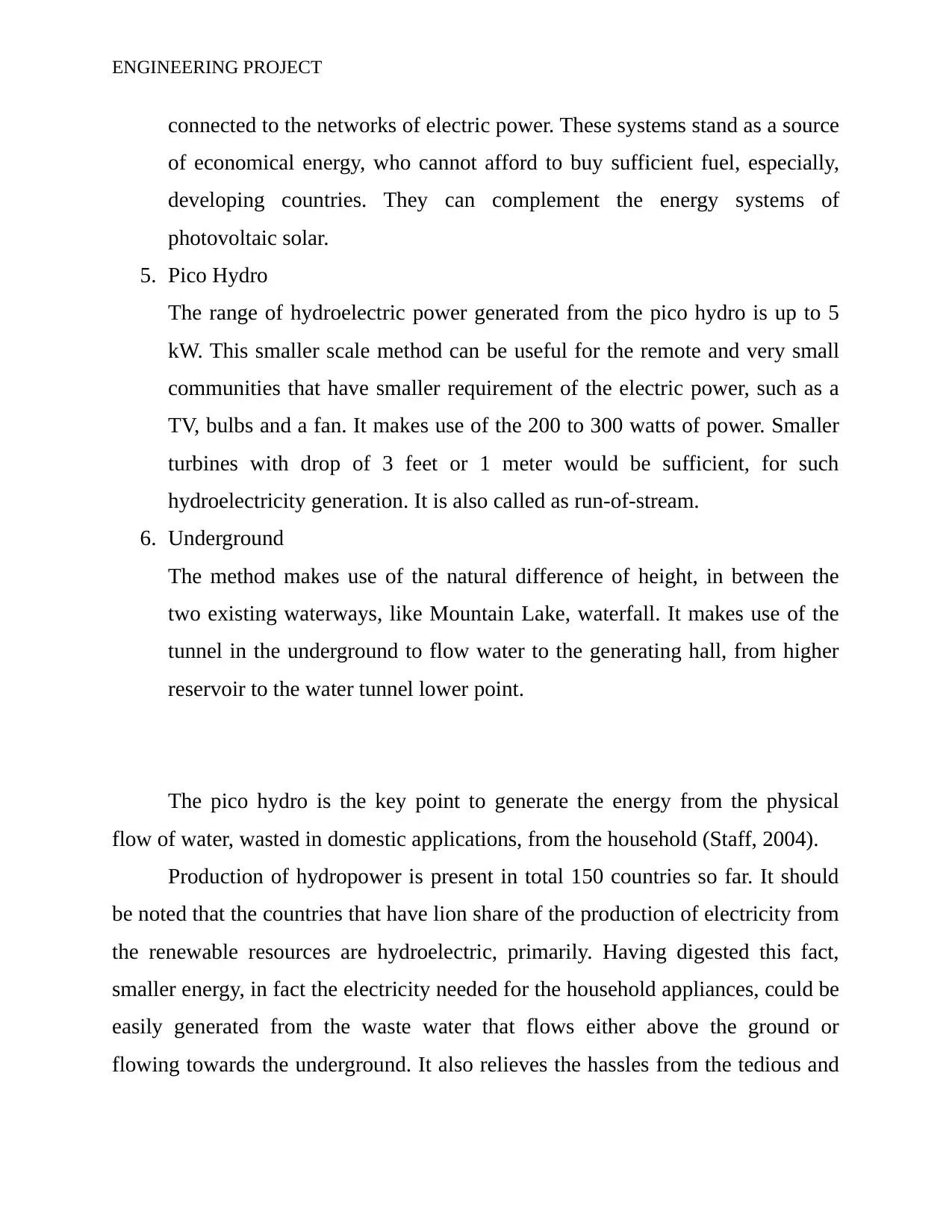
ENGINEERING PROJECT
connected to the networks of electric power. These systems stand as a source
of economical energy, who cannot afford to buy sufficient fuel, especially,
developing countries. They can complement the energy systems of
photovoltaic solar.
5. Pico Hydro
The range of hydroelectric power generated from the pico hydro is up to 5
kW. This smaller scale method can be useful for the remote and very small
communities that have smaller requirement of the electric power, such as a
TV, bulbs and a fan. It makes use of the 200 to 300 watts of power. Smaller
turbines with drop of 3 feet or 1 meter would be sufficient, for such
hydroelectricity generation. It is also called as run-of-stream.
6. Underground
The method makes use of the natural difference of height, in between the
two existing waterways, like Mountain Lake, waterfall. It makes use of the
tunnel in the underground to flow water to the generating hall, from higher
reservoir to the water tunnel lower point.
The pico hydro is the key point to generate the energy from the physical
flow of water, wasted in domestic applications, from the household (Staff, 2004).
Production of hydropower is present in total 150 countries so far. It should
be noted that the countries that have lion share of the production of electricity from
the renewable resources are hydroelectric, primarily. Having digested this fact,
smaller energy, in fact the electricity needed for the household appliances, could be
easily generated from the waste water that flows either above the ground or
flowing towards the underground. It also relieves the hassles from the tedious and
connected to the networks of electric power. These systems stand as a source
of economical energy, who cannot afford to buy sufficient fuel, especially,
developing countries. They can complement the energy systems of
photovoltaic solar.
5. Pico Hydro
The range of hydroelectric power generated from the pico hydro is up to 5
kW. This smaller scale method can be useful for the remote and very small
communities that have smaller requirement of the electric power, such as a
TV, bulbs and a fan. It makes use of the 200 to 300 watts of power. Smaller
turbines with drop of 3 feet or 1 meter would be sufficient, for such
hydroelectricity generation. It is also called as run-of-stream.
6. Underground
The method makes use of the natural difference of height, in between the
two existing waterways, like Mountain Lake, waterfall. It makes use of the
tunnel in the underground to flow water to the generating hall, from higher
reservoir to the water tunnel lower point.
The pico hydro is the key point to generate the energy from the physical
flow of water, wasted in domestic applications, from the household (Staff, 2004).
Production of hydropower is present in total 150 countries so far. It should
be noted that the countries that have lion share of the production of electricity from
the renewable resources are hydroelectric, primarily. Having digested this fact,
smaller energy, in fact the electricity needed for the household appliances, could be
easily generated from the waste water that flows either above the ground or
flowing towards the underground. It also relieves the hassles from the tedious and

ENGINEERING PROJECT
expensive process of distribution of electricity, from the central electricity
generation grids (Sørensen, 2004).
Advantages
Water energy is the preferred renewable energy in the world so far, for the
following advantages (Engler, 2006).
1. Water is an easily available resource to convert into the required form of
energy.
2. Water is not consumed or wasted in the hydroelectricity.
3. It is not an expensive method of conversion of energy.
4. It allows distributed power generation, which is easier than the central power
generation and distributing with expensive infrastructure for the same.
5. There is no waste of energy generated.
6. The method releases no harm or pollutants to environment and so to the
human kind.
7. It does not allow diminishing the fossil fuel, which are less available and
limited.
8. Hydropower is flexible enough, since it can be changed up and down, so
easily and quickly to the dynamic changes of electricity demand.
9. High value power can be generated, because of the clean electricity
produced, from hydroelectricity.
10.The average electricity cost, from the hydro station is very less, of 3 to 5 US
cents for 10 megawatts, per kilowatt-hour.
11.Can produce intermittent energy
12.Lower operating labour cost
13.Low cost of construction for the dams and can be offset in shorter time.
14.Suitable for industrial applications also.
15.Reduced emissions of carbon dioxide
expensive process of distribution of electricity, from the central electricity
generation grids (Sørensen, 2004).
Advantages
Water energy is the preferred renewable energy in the world so far, for the
following advantages (Engler, 2006).
1. Water is an easily available resource to convert into the required form of
energy.
2. Water is not consumed or wasted in the hydroelectricity.
3. It is not an expensive method of conversion of energy.
4. It allows distributed power generation, which is easier than the central power
generation and distributing with expensive infrastructure for the same.
5. There is no waste of energy generated.
6. The method releases no harm or pollutants to environment and so to the
human kind.
7. It does not allow diminishing the fossil fuel, which are less available and
limited.
8. Hydropower is flexible enough, since it can be changed up and down, so
easily and quickly to the dynamic changes of electricity demand.
9. High value power can be generated, because of the clean electricity
produced, from hydroelectricity.
10.The average electricity cost, from the hydro station is very less, of 3 to 5 US
cents for 10 megawatts, per kilowatt-hour.
11.Can produce intermittent energy
12.Lower operating labour cost
13.Low cost of construction for the dams and can be offset in shorter time.
14.Suitable for industrial applications also.
15.Reduced emissions of carbon dioxide
⊘ This is a preview!⊘
Do you want full access?
Subscribe today to unlock all pages.

Trusted by 1+ million students worldwide
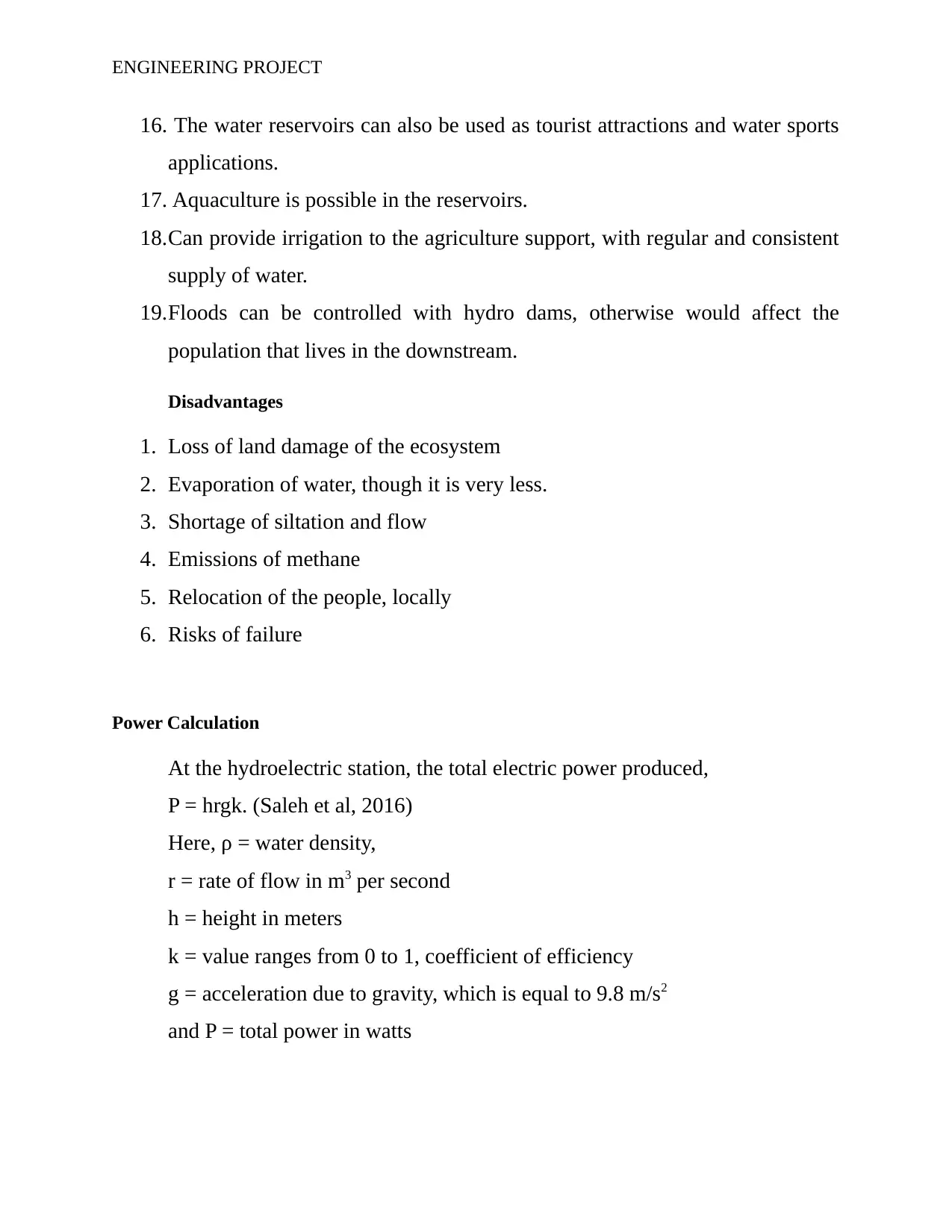
ENGINEERING PROJECT
16. The water reservoirs can also be used as tourist attractions and water sports
applications.
17. Aquaculture is possible in the reservoirs.
18.Can provide irrigation to the agriculture support, with regular and consistent
supply of water.
19.Floods can be controlled with hydro dams, otherwise would affect the
population that lives in the downstream.
Disadvantages
1. Loss of land damage of the ecosystem
2. Evaporation of water, though it is very less.
3. Shortage of siltation and flow
4. Emissions of methane
5. Relocation of the people, locally
6. Risks of failure
Power Calculation
At the hydroelectric station, the total electric power produced,
P = hrgk. (Saleh et al, 2016)
Here, ρ = water density,
r = rate of flow in m3 per second
h = height in meters
k = value ranges from 0 to 1, coefficient of efficiency
g = acceleration due to gravity, which is equal to 9.8 m/s2
and P = total power in watts
16. The water reservoirs can also be used as tourist attractions and water sports
applications.
17. Aquaculture is possible in the reservoirs.
18.Can provide irrigation to the agriculture support, with regular and consistent
supply of water.
19.Floods can be controlled with hydro dams, otherwise would affect the
population that lives in the downstream.
Disadvantages
1. Loss of land damage of the ecosystem
2. Evaporation of water, though it is very less.
3. Shortage of siltation and flow
4. Emissions of methane
5. Relocation of the people, locally
6. Risks of failure
Power Calculation
At the hydroelectric station, the total electric power produced,
P = hrgk. (Saleh et al, 2016)
Here, ρ = water density,
r = rate of flow in m3 per second
h = height in meters
k = value ranges from 0 to 1, coefficient of efficiency
g = acceleration due to gravity, which is equal to 9.8 m/s2
and P = total power in watts
Paraphrase This Document
Need a fresh take? Get an instant paraphrase of this document with our AI Paraphraser
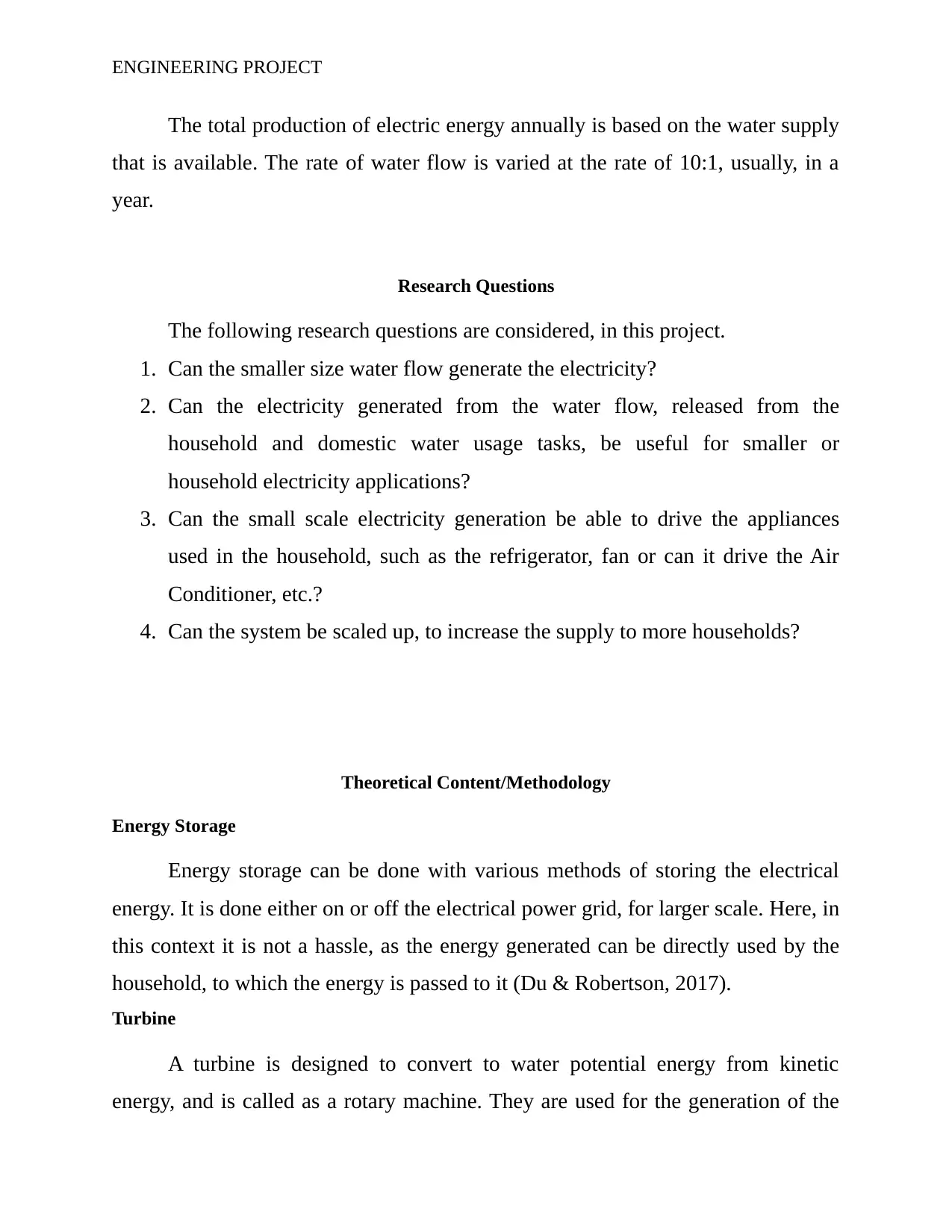
ENGINEERING PROJECT
The total production of electric energy annually is based on the water supply
that is available. The rate of water flow is varied at the rate of 10:1, usually, in a
year.
Research Questions
The following research questions are considered, in this project.
1. Can the smaller size water flow generate the electricity?
2. Can the electricity generated from the water flow, released from the
household and domestic water usage tasks, be useful for smaller or
household electricity applications?
3. Can the small scale electricity generation be able to drive the appliances
used in the household, such as the refrigerator, fan or can it drive the Air
Conditioner, etc.?
4. Can the system be scaled up, to increase the supply to more households?
Theoretical Content/Methodology
Energy Storage
Energy storage can be done with various methods of storing the electrical
energy. It is done either on or off the electrical power grid, for larger scale. Here, in
this context it is not a hassle, as the energy generated can be directly used by the
household, to which the energy is passed to it (Du & Robertson, 2017).
Turbine
A turbine is designed to convert to water potential energy from kinetic
energy, and is called as a rotary machine. They are used for the generation of the
The total production of electric energy annually is based on the water supply
that is available. The rate of water flow is varied at the rate of 10:1, usually, in a
year.
Research Questions
The following research questions are considered, in this project.
1. Can the smaller size water flow generate the electricity?
2. Can the electricity generated from the water flow, released from the
household and domestic water usage tasks, be useful for smaller or
household electricity applications?
3. Can the small scale electricity generation be able to drive the appliances
used in the household, such as the refrigerator, fan or can it drive the Air
Conditioner, etc.?
4. Can the system be scaled up, to increase the supply to more households?
Theoretical Content/Methodology
Energy Storage
Energy storage can be done with various methods of storing the electrical
energy. It is done either on or off the electrical power grid, for larger scale. Here, in
this context it is not a hassle, as the energy generated can be directly used by the
household, to which the energy is passed to it (Du & Robertson, 2017).
Turbine
A turbine is designed to convert to water potential energy from kinetic
energy, and is called as a rotary machine. They are used for the generation of the
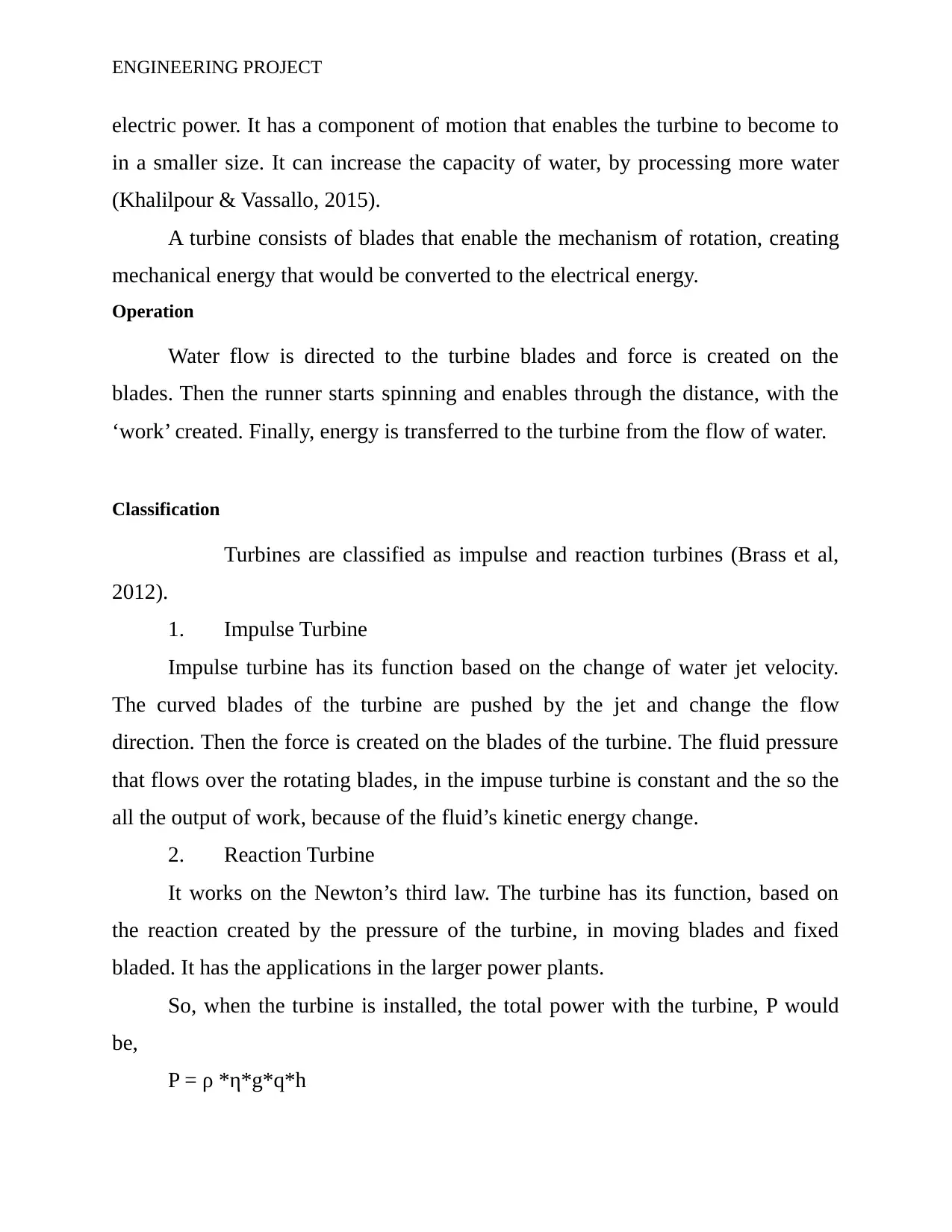
ENGINEERING PROJECT
electric power. It has a component of motion that enables the turbine to become to
in a smaller size. It can increase the capacity of water, by processing more water
(Khalilpour & Vassallo, 2015).
A turbine consists of blades that enable the mechanism of rotation, creating
mechanical energy that would be converted to the electrical energy.
Operation
Water flow is directed to the turbine blades and force is created on the
blades. Then the runner starts spinning and enables through the distance, with the
‘work’ created. Finally, energy is transferred to the turbine from the flow of water.
Classification
Turbines are classified as impulse and reaction turbines (Brass et al,
2012).
1. Impulse Turbine
Impulse turbine has its function based on the change of water jet velocity.
The curved blades of the turbine are pushed by the jet and change the flow
direction. Then the force is created on the blades of the turbine. The fluid pressure
that flows over the rotating blades, in the impuse turbine is constant and the so the
all the output of work, because of the fluid’s kinetic energy change.
2. Reaction Turbine
It works on the Newton’s third law. The turbine has its function, based on
the reaction created by the pressure of the turbine, in moving blades and fixed
bladed. It has the applications in the larger power plants.
So, when the turbine is installed, the total power with the turbine, P would
be,
P = ρ *η*g*q*h
electric power. It has a component of motion that enables the turbine to become to
in a smaller size. It can increase the capacity of water, by processing more water
(Khalilpour & Vassallo, 2015).
A turbine consists of blades that enable the mechanism of rotation, creating
mechanical energy that would be converted to the electrical energy.
Operation
Water flow is directed to the turbine blades and force is created on the
blades. Then the runner starts spinning and enables through the distance, with the
‘work’ created. Finally, energy is transferred to the turbine from the flow of water.
Classification
Turbines are classified as impulse and reaction turbines (Brass et al,
2012).
1. Impulse Turbine
Impulse turbine has its function based on the change of water jet velocity.
The curved blades of the turbine are pushed by the jet and change the flow
direction. Then the force is created on the blades of the turbine. The fluid pressure
that flows over the rotating blades, in the impuse turbine is constant and the so the
all the output of work, because of the fluid’s kinetic energy change.
2. Reaction Turbine
It works on the Newton’s third law. The turbine has its function, based on
the reaction created by the pressure of the turbine, in moving blades and fixed
bladed. It has the applications in the larger power plants.
So, when the turbine is installed, the total power with the turbine, P would
be,
P = ρ *η*g*q*h
⊘ This is a preview!⊘
Do you want full access?
Subscribe today to unlock all pages.

Trusted by 1+ million students worldwide
1 out of 24
Related Documents
Your All-in-One AI-Powered Toolkit for Academic Success.
+13062052269
info@desklib.com
Available 24*7 on WhatsApp / Email
![[object Object]](/_next/static/media/star-bottom.7253800d.svg)
Unlock your academic potential
Copyright © 2020–2025 A2Z Services. All Rights Reserved. Developed and managed by ZUCOL.




